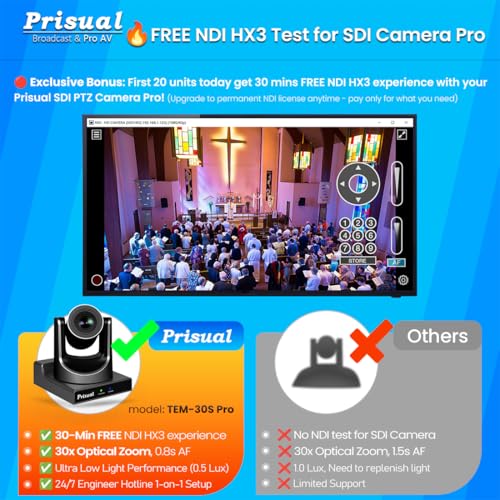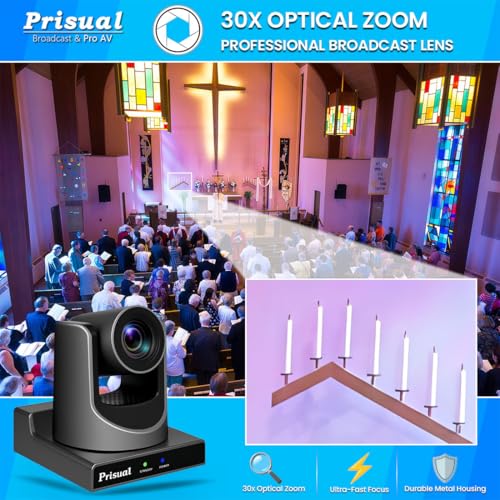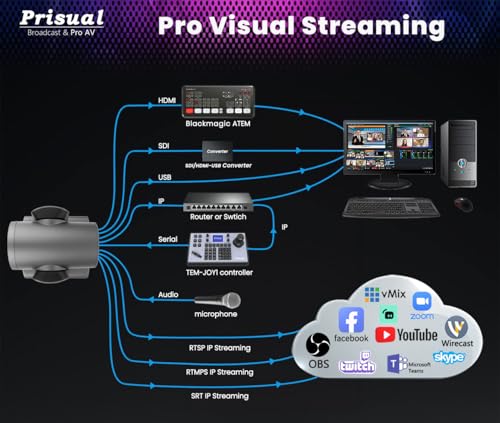



As a security enthusiast and a technology lover, I have always been fascinated by the advancements in the field of surveillance cameras. With the rise in crime rates and security concerns, having a reliable and secure IP camera system has become a necessity.
When it comes to choosing the best secure IP camera protocol, there are several options available in the market. Each protocol has its own strengths and weaknesses, and it is important to select the one that best fits your security needs.
One of the most popular and secure IP camera protocols is Secure Real-time Transport Protocol (SRTP). SRTP ensures the confidentiality, integrity, and authentication of the video stream, making it nearly impossible for hackers to intercept or tamper with the data.
Another reliable option is Transport Layer Security (TLS). TLS provides end-to-end encryption, protecting the video stream from unauthorized access. With TLS, you can be confident that your surveillance footage remains secure and private.
Lastly, Internet Protocol Security (IPSec) is a robust protocol that offers secure communication over IP networks. IPSec provides authentication, encryption, and data integrity, ensuring that your IP camera system is protected from any potential threats.
In conclusion, choosing the best secure IP camera protocol is crucial for ensuring the safety and privacy of your surveillance footage. Whether you opt for SRTP, TLS, or IPSec, it is important to prioritize security when selecting an IP camera system.
What is an IP camera protocol?
An IP camera protocol is a set of rules and standards that govern the communication between an IP camera and other devices on a network. It defines how the camera transmits and receives data, as well as how it is controlled and managed.
There are several different protocols that IP cameras can use, each with its own advantages and disadvantages. Some of the most common protocols include:
- HTTP: This is the most basic protocol and is used for viewing camera feeds through a web browser. It is simple and widely supported, but it does not provide encryption or authentication, making it less secure.
- RTSP: This protocol is commonly used for streaming video and audio from IP cameras. It provides better performance and supports multiple camera feeds, but it may require additional software or configuration to work properly.
- ONVIF: ONVIF is a widely adopted protocol that allows IP cameras from different manufacturers to communicate with each other. It provides interoperability between devices and simplifies the integration of cameras into larger surveillance systems.
In conclusion, an IP camera protocol is a crucial component of any IP camera system. It determines how the camera communicates with other devices and affects factors such as performance, security, and interoperability. Choosing the right protocol for your specific needs is important to ensure a reliable and secure surveillance system.
Importance of choosing a secure IP camera protocol
In today’s digital age, security is of utmost importance. Whether it’s protecting our homes, businesses, or personal information, we all want peace of mind knowing that our assets are safe. When it comes to IP cameras, choosing a secure protocol is essential to ensure the integrity and confidentiality of the video footage being recorded.
A secure IP camera protocol provides several benefits. Firstly, it helps prevent unauthorized access to the camera feed. By using encryption techniques, the protocol ensures that only authorized individuals can view the footage, reducing the risk of privacy breaches or potential misuse of the recorded content. Additionally, a secure protocol helps protect against tampering or alteration of the video feed, ensuring the accuracy and reliability of the footage.
One popular secure IP camera protocol is Secure Real-time Transport Protocol (SRTP). SRTP combines the benefits of Real-time Transport Protocol (RTP) with encryption mechanisms to provide a secure and reliable video streaming experience. Another option is Secure Shell (SSH), which provides secure remote access to IP cameras and allows for secure file transfers. Additionally, Transport Layer Security (TLS) can be used to secure the communication between the camera and the recording device, ensuring the confidentiality and integrity of the video feed.
Choosing a secure IP camera protocol is crucial for protecting your privacy and ensuring the safety of your assets. By selecting a protocol that incorporates encryption and authentication mechanisms, you can have confidence in the security of your IP camera system. Remember to always research and choose the most secure protocol that aligns with your specific needs and requirements.
Comparison of popular IP camera protocols
When it comes to choosing the best IP camera protocol for your security needs, it’s important to understand the differences between the most popular options available. In this comparison, I will discuss some of the key features and advantages of three widely used protocols: ONVIF, RTSP, and HTTP.
ONVIF
ONVIF (Open Network Video Interface Forum) is a global standard for IP-based security products. It allows for interoperability between different brands and models of IP cameras, video management systems, and other network video devices. The main advantage of ONVIF is its ability to provide a unified interface and a standardized way of communication between devices, making it easier to integrate and manage security systems.
With ONVIF, you can easily connect and control multiple cameras from different manufacturers using a single software interface. It also supports advanced features such as PTZ (pan-tilt-zoom) control, event triggers, and video analytics. Additionally, ONVIF ensures that your IP camera system is future-proof, as it is constantly updated and improved by the industry.
RTSP
RTSP (Real Time Streaming Protocol) is a protocol designed for real-time streaming of audio and video data over IP networks. It is widely used for video surveillance applications and allows for high-quality video transmission with low latency. RTSP supports various video codecs and can be easily integrated with other IP-based systems.
One of the advantages of RTSP is its flexibility in terms of video management and control. It allows for remote viewing, recording, and playback of video streams from IP cameras. RTSP also supports features such as motion detection, audio streaming, and two-way communication. However, it is important to note that RTSP does not provide a standardized way of communication between different devices, which can make integration more complex.
HTTP
HTTP (Hypertext Transfer Protocol) is the protocol used for transmitting data over the internet. While it is not specifically designed for IP camera systems, it is commonly used for accessing the video feed and controlling IP cameras through a web browser. HTTP provides a user-friendly interface with easy-to-use controls and settings.
One of the advantages of HTTP is its simplicity and compatibility with most web browsers and devices. It allows for remote access to live video streams, as well as playback and download of recorded footage. However, HTTP may not be suitable for high-resolution video transmission or real-time monitoring, as it can have higher latency compared to other protocols.
- ONVIF provides a standardized way of communication between devices and supports advanced features.
- RTSP offers high-quality video streaming and flexibility in video management.
- HTTP is user-friendly and compatible with most web browsers, but may not be suitable for real-time monitoring.
Ultimately, the choice of IP camera protocol depends on your specific requirements and preferences. It is important to consider factors such as interoperability, video quality, control options, and future scalability when making a decision.
The benefits of using a secure IP camera protocol
As a security professional, I understand the importance of using a secure IP camera protocol. By implementing a secure protocol, such as HTTPS or Secure Real-Time Transport Protocol (SRTP), I can ensure that the data transmitted between the IP camera and the server remains encrypted and protected from unauthorized access.
One of the key benefits of using a secure IP camera protocol is the increased level of data confidentiality. With encryption in place, any sensitive information captured by the IP camera, such as video footage or audio recordings, is safeguarded from being intercepted or viewed by unauthorized individuals. This is particularly important in environments where privacy is a concern, such as in residential areas or corporate offices.
Another advantage of using a secure protocol is the enhanced integrity of the data transmitted. With data encryption, the integrity of the information captured by the IP camera is preserved throughout the transmission process. This ensures that the data remains unchanged and unaltered, preventing any potential tampering or manipulation. By maintaining data integrity, I can trust that the footage captured by the IP camera is accurate and reliable.
Furthermore, a secure IP camera protocol provides an additional layer of authentication and access control. By implementing protocols that require proper authentication, such as username and password or digital certificates, I can ensure that only authorized individuals have access to the camera feed. This helps to prevent unauthorized access and unauthorized use of the IP camera system, minimizing the risk of security breaches.
In conclusion, using a secure IP camera protocol offers several benefits, including increased data confidentiality, enhanced data integrity, and improved authentication and access control. By implementing these protocols, I can provide a higher level of security and protection for the IP camera system, ensuring the privacy and safety of the captured data.
Top secure IP camera protocols for enhanced security
When it comes to securing IP cameras, choosing the right protocol is crucial. There are several protocols available that provide enhanced security measures for IP cameras. In this article, I will discuss some of the top secure IP camera protocols that are widely used and recommended by security experts.
Secure Real-time Transport Protocol (SRTP): SRTP is a secure protocol that provides encryption, authentication, and integrity for the transmission of video and audio data. It ensures that the data exchanged between the IP camera and the monitoring device is protected from unauthorized access and tampering. SRTP uses encryption algorithms to secure the data, making it difficult for hackers to intercept or manipulate the video feed.
Transport Layer Security (TLS): TLS is a widely adopted protocol for securing network communications. It provides end-to-end encryption and authentication, ensuring that the data transmitted between the IP camera and the monitoring device is protected from eavesdropping and tampering. TLS uses certificates to establish a secure connection, and it supports various encryption algorithms to ensure the confidentiality and integrity of the data.
- Secure Shell (SSH): SSH is a secure protocol that allows secure remote access to IP cameras. It provides strong encryption and authentication, preventing unauthorized access to the camera’s settings and configuration. SSH uses public-key cryptography to authenticate the remote user and establish a secure connection. By using SSH, you can securely manage and monitor your IP cameras from anywhere in the world.
- Internet Protocol Security (IPsec): IPsec is a protocol suite that provides secure communication over IP networks. It offers authentication, encryption, and integrity for the transmission of data between IP cameras and monitoring devices. IPsec can be used to create a virtual private network (VPN) to establish a secure connection between remote locations. By using IPsec, you can ensure the confidentiality and integrity of the video feed transmitted over the network.
- Secure HTTP (HTTPS): HTTPS is a secure protocol that encrypts the communication between web browsers and web servers. It can also be used to secure the access to IP cameras through a web interface. By enabling HTTPS on your IP camera, you can ensure that the login credentials and video feed are protected from unauthorized access and interception. HTTPS uses SSL/TLS certificates to establish a secure connection, providing enhanced security for remote access to IP cameras.
In conclusion, choosing the right protocol is essential for enhancing the security of your IP cameras. By using protocols like SRTP, TLS, SSH, IPsec, and HTTPS, you can ensure that the data transmitted between the IP camera and the monitoring device is protected from unauthorized access, eavesdropping, and tampering.
Conclusion
In conclusion, choosing the best secure IP camera protocol for your needs requires careful consideration of several factors. Firstly, you should assess the level of security provided by each protocol, taking into account encryption methods, authentication mechanisms, and vulnerability to hacking. Additionally, you should consider the compatibility of the protocol with your existing network infrastructure and devices.
It is important to prioritize protocols that offer end-to-end encryption and strong authentication mechanisms, such as HTTPS or RTSP over TLS. These protocols ensure that your video feed is protected from unauthorized access and interception. Furthermore, protocols that support two-factor authentication or biometric authentication provide an extra layer of security.
Another consideration is the scalability and flexibility of the protocol. Look for protocols that can support a large number of cameras and offer features such as remote management, video analytics, and integration with other security systems.
Ultimately, the best secure IP camera protocol for your needs will depend on your specific requirements and the level of security you desire. It is recommended to consult with a security professional or IT expert to determine the most suitable protocol for your situation.
Best secure ip camera protocol
Features
| Part Number | SD8POE-5MP-HX |
| Model | SD8POE-5MP-HX |
| Color | White 2 |
| Size | 1 Count (Pack of 1) |
| Price history for Outdoor 5MP POE PTZ Security Camera | |
|---|---|
|
Latest updates:
|
|
Features
| Model | TP4CV-CP |
| Warranty | Manufacturer warranty for one year from date of purchase |
| Size | 20X 5MP |
| Price history for AI-Driven Outdoor 20X PTZ Camera | |
|---|---|
|
Latest updates:
|
|
Features
| Part Number | TEM-30V |
| Model | 30X PTZ Camera Pro |
| Warranty | 24 months local warranty in the United States |
| Color | grey |
| Size | 30X PTZ Camera Pro |
| Price history for 30X Optical Zoom Live Streaming Camera | |
|---|---|
|
Latest updates:
|
|
Features
| Part Number | ANGELBOX1 |
| Model | ANGELBOX1 |
Questions and answers:
What is the best secure IP camera protocol?
The best secure IP camera protocol is considered to be the Secure Real-time Transport Protocol (SRTP) which provides end-to-end encryption for video and audio streams.
How does Secure Real-time Transport Protocol (SRTP) ensure security for IP cameras?
SRTP ensures security for IP cameras by encrypting the video and audio streams, making it difficult for unauthorized users to intercept and view the data.
Are there any other secure IP camera protocols besides SRTP?
Yes, besides SRTP, there are other secure IP camera protocols such as Transport Layer Security (TLS), Secure Shell (SSH), and Internet Protocol Security (IPSec) that can also provide encryption and security for IP camera data.
Which secure IP camera protocol is the most widely used?
Transport Layer Security (TLS) is the most widely used secure IP camera protocol as it provides encryption and security for a wide range of applications, including IP cameras.
Can I use multiple secure IP camera protocols for added security?
Yes, you can use multiple secure IP camera protocols to enhance security. However, it is important to ensure compatibility between the protocols and the IP camera system.


































